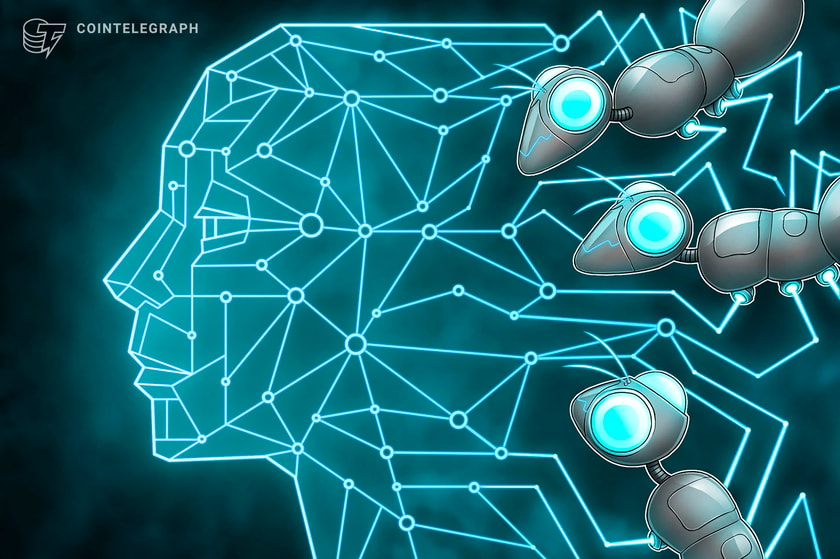Can blockchain supply the guardrails to keep AI on course?

Some believe that hybrid blockchains with both private and public aspects can solve AI’s black-box problem.
Artificial intelligence (AI) and blockchain are emerging digital technologies that have captured the public imagination but also raised serious concerns.
So it bears asking: Can AI and blockchain be integrated in a way that benefits humanity?
There are reasons to think so. As far back as 2016, Vitalik Buterin wrote that both the crypto economics and AI safety communities were “trying to tackle what is fundamentally the same problem” of how to regulate complex and smart systems with “unpredictable emergent properties.”
Both rely for control on essentially “dumb” systems “whose properties once created are inflexible,” after all. Once a smart contract is implemented, it can’t be changed, for instance. The two communities “should listen to each other more,” he concluded.
In the past year, with the emergence of ChatGPT and other generative AI tools, worries are growing that AI may be spinning out of control. Humans could lose control over autonomous weapons systems in one nightmarish scenario.
So, the notion that blockchains and smart contracts can somehow serve as guardrails to stop AI models from veering off course has been gaining currency.
“Everyone working in crypto has a really distinct role to play in making AGI go well,” said Allison Duettmann, president of the Foresight Institute, at the recent SmartCon 2023 conference. This is especially so given predictions that artificial general intelligence, or AGI, where machines achieve human-level intelligence, may be coming sooner rather than later.
This potential fusion of AI and blockchain tech was also on the minds of IT decision-makers who participated in a recently-released survey commissioned by Casper Labs. Almost half (48%) of the 608 IT leaders surveyed across the United States, Europe and China agreed that “the integration of AI and blockchain technology has the potential to revolutionize our industry, enabling enhanced data security, transparency, and efficiency.”
Complementary technologies, growing momentum
The basic idea is that blockchains’ immutable, tamper-free ledgers, together with smart contracts, may provide the guardrails for AI implementations, ensuring responsible artificial intelligence. A blockchain could even serve as a sort of “kill switch” for out-of-control AI models, some believe.
In the Casper Labs-commissioned survey by Zogby Analytics, 71% of IT leaders said they “view blockchain and AI as complementary technologies.” Moreover, when asked how their organizations currently use blockchain, “working efficiently with AI was the most popular response overall (51%).”
Elsewhere, on Nov. 1, U.S. President Joe Biden issued an executive order establishing new AI safety and security standards. The order aims to protect the public against a wide range of risks, including dangerous AI-engineered biological materials, AI-enabled fraud and deception.

That order “created a lot of momentum,” Mrinal Manohar, CEO and co-founder of Casper Labs, which has a layer-1 blockchain focused on businesses, told Cointelegraph in an interview. AI governance is on the minds of more enterprise IT people these days.
Does he see more businesses launching actual AI/blockchain projects? “We anticipate 2024 will be a year of big POCs [proofs-of-concept] and MVPs [minimum viable products]. And after that I anticipate there’ll be actual use cases,” said Manohar.
But surely there are obstacles here, including scaling. Validating transactions promptly in high-volume decentralized blockchains remains a challenge, even though progress has been made recently.
In an oft-cited 2021 paper, Ben Garfinkel, director of the Centre for the Governance of AI, wrote that “established permissionless blockchains, including Ethereum, are too inefficient to run anything beyond fairly simple applications.” Even an application “that checks who has won a game of chess is pushing up against Ethereum’s current limitations.”
Magazine: Breaking into Liberland: Dodging guards with inner-tubes, decoys and diplomats
Still, if smart contracts “ever become sufficiently reliable,” Garfinkel allowed, they could be useful as verification mechanisms for international agreements aimed at governing AI systems.
Casper Labs is clearly more optimistic. “In the race to solve AI’s ‘black box’ challenge, blockchain is emerging as the all-in-one solution we’ve been waiting for to incorporate much-needed transparency,” wrote Manohar in the report. AI systems’ internal workings are basically invisible to users, hence the “black box” analogy.
The hybrid blockchain solution
Still, how can blockchain technology possibly be viewed as a solution to AI’s “black box” problem if it can’t even scale?
“The way you address the scaling problem is through hybrid blockchains,” Manohar told Cointelegraph. No one today is talking about putting enormous data sets on Ethereum or on Casper Labs’ own layer-1 blockchain. Casper Labs’ solution involves using both permissioned (private) blockchains and public (non-permissioned) ones.
“People have forced themselves into this kind of thinking where you have to be completely permissioned or you have to be completely open,” said Manohar, further explaining:
“In a hybrid blockchain, you have your own private blockchain that’s yours. You control it, you configure it, and you can make that run as fast as you want because you have a limited validator set.”
And the public chain? That’s more for version control and record keeping. You might want to register a new version of AI on the public chain, for instance. “The beauty of this hybrid model is you choose when you need immutability from the public chain and where you just manage your infrastructure on your own,” said Manohar.
As long as you store the reference on the public blockchain adequately, “you can always ensure that that data was not tampered with because if it was tampered with, the hashes wouldn’t match.”
Also, anything that you want to be auditable, you can put on the public blockchain because it’s tamper-proof. So “every time I modify the AI or every time I use a new data set, I will send a ping to the public blockchain,” said Manohar.
A big problem with AI today is that one doesn’t know when something goes wrong. But blockchains provide a way to roll back the tape, so to speak, because they are highly serialized and time-stamped.
Thus, if an AI model “begins to show signs of hallucination or inherent biases, you can simply roll the AI system back to a recent iteration that lacked those issues, and subsequently diagnose where the problem data came from,” Casper Labs notes on its website.
But others aren’t convinced that a blockchain can solve AI’s “black box” problem.
“It’s misleading to describe blockchain’s ‘transparency’ as an antidote to AI’s ‘black box’ problem,” Samir Rawashdeh, associate professor and director of the Dearborn Artificial Intelligence Research Center at the University of Michigan, Dearborn, told Cointelegraph.
It does not make the inherent inner workings of a machine learning model more understandable or make clear “in what way a particular output traces back to the original training data.”
What Casper Labs is really proposing, suggested Rawashdeh, is a “version control system” — albeit with some nice features — that can be used “to keep track of the AI model’s development and deployment.”
That said, a blockchain could indirectly address the “black box” challenge, Rawashdeh added, by offering up an audit trail that helps ensure data integrity, provenance and transparency in the data sets used to train AI models. But it doesn’t make the actual decision process any more interpretable.
When machines collude against human beings
Looking ahead, concerns arise around artificial general intelligence: Could blockchain help to avoid those bad-dream scenarios where AGI models overturn elections or even prosecute wars?
“It actually could immensely help,” answered Manohar. Blockchain “would be the best kill switch” for an AI model provided its electrical power “goes through a completely decentralized blockchain.”
That is, the blockchain and its human validators decide if the AI model receives power or not. “There’s always a kill switch signal, where if all the validators agree, they can just shut down the network, shut down the AI’s access to power,” said Manohar, adding:
“It actually could act as an incredibly potent kill switch for those nightmare scenarios.”
Suspicions remain
There are other potential hindrances to this integration of blockchain and AI. For one thing, “there’s just a lot of suspicion in the AI community around crypto,” Duettmann said. Crypto and blockchain still bring to mind nonfungible token scams and other unsavory behavior for many.
That said, when asked if Foresight was seeing more funding proposals for AI/Blockchain projects, Duettmann answered: “There’s a lot just like movement in the space now.” She’s seeing, on average, about five funding proposals a week that combine blockchain and AI technology. Of course, the Institute can only fund a fraction of these, but “it’s definitely picked up a lot.”
As to the two communities, “ultimately they have a lot to learn from each other,” she said. In her SmartCon 2023 talk, she noted that the crypto industry is very good at network security, often employing “red teaming,” wherein teams search for inputs that cause catastrophic behavior. “Let’s extend ‘red teaming’ to machine learning models,” she proposed.
More acceptance in China
Integrating AI and blockchain technology seems to be viewed particularly favorably in China. In Casper Lab’s survey, 68% of China’s IT respondents agreed that “the integration of AI and blockchain technology has the potential to revolutionize our industry, enabling enhanced data security, transparency, and efficiency.” By comparison, that share was 48% in the U.S. and only 34% in Europe.
Recent: Boosting blockchain adoption by keeping tech on the back end
Why so high in China? China has been hostile toward cryptocurrencies in recent years but remains positive about blockchain technology, observed Manohar. Some municipalities have put land deeds on a blockchain. China views blockchain technology as an effective certification and tracking mechanism.
In the West, by comparison, “everyone thinks blockchain is just cryptocurrency,” asserted Manohar. But this education gap is likely to narrow. In the long term, “everything reverts to the mean.”
Is this blockchain’s killer app?
Manohar was asked if the fusion of AI and blockchain could eventually amount to blockchain’s long-sought “killer app.”
“It could be one of them,” he answered. Blockchain’s track-and-trace governance protocols for the supply chain and financial technology sectors are also candidates, but those two areas had passable governance before blockchains and smart contracts ever appeared.
By comparison, “there is no incumbent governance system in AI. Therefore, there’s much more space for innovation. So I really do think this could be blockchain’s killer app,” he told Cointelegraph.








